Introduction: Why Dishwasher Replacement Cost Matters
Dishwashers have become an essential appliance in modern kitchens, saving time, water, and effort in daily routines. But like any machine, dishwashers eventually wear out or become too inefficient to repair, leaving homeowners with a crucial decision: replace or repair. Understanding the dishwasher replacement cost is vital because it not only influences your budget but also helps you weigh whether a repair is worthwhile or if investing in a new unit is the smarter long-term choice.
On average, replacing a dishwasher involves two major expenses—the cost of the appliance itself and the cost of professional installation. While some budget-friendly dishwashers are available for a few hundred dollars, premium models with advanced features like smart connectivity, ultra-quiet operation, and stainless steel tubs can exceed a thousand dollars. Installation costs can also vary widely depending on whether the replacement is a simple swap or if new plumbing or electrical work is required.
Factoring in dishwasher replacement cost is not just about the upfront price tag. Long-term savings from water-efficient and energy-efficient models can offset the initial investment over time. Additionally, understanding labor charges, disposal fees for the old unit, and potential cabinetry modifications ensures you won’t be caught off guard by hidden expenses. For families and busy households, knowing these details helps with budgeting, avoiding unexpected costs, and selecting the right dishwasher that fits both lifestyle and financial goals.
This guide will walk you through every aspect of dishwasher replacement cost—from essential tools and preparation, to step-by-step replacement instructions, common mistakes to avoid, and expert insights. Whether you’re handling a simple upgrade or a more complex kitchen remodel, this breakdown will equip you with the knowledge to make an informed decision.
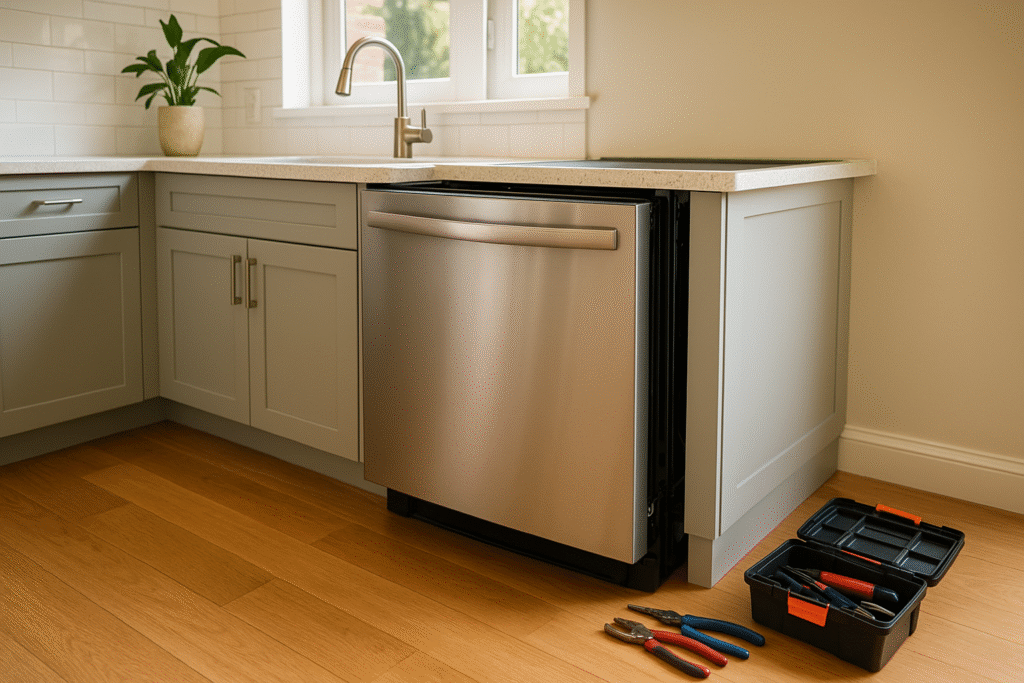
What You’ll Need Before You Start
Before diving into the process and fully understanding the dishwasher replacement cost, it’s essential to gather the right tools, materials, and knowledge. Preparing ahead of time ensures the installation goes smoothly, prevents delays, and reduces the chances of unexpected expenses. Even if you plan to hire a professional installer, being aware of what’s needed allows you to budget accurately and avoid surprise costs.
The most critical item is, of course, the new dishwasher itself. Models vary widely in price, starting as low as $300 for basic units and reaching over $1,500 for premium models with advanced features such as smart connectivity, quiet operation, or stainless-steel interiors. Alongside the appliance, you’ll need a compatible installation kit, which usually includes a water inlet hose, drain hose, clamps, and necessary fittings. Some dishwashers come with these items, but in many cases they are sold separately and add $20–$50 to the overall dishwasher replacement cost.
For tools, you’ll need an adjustable wrench, screwdrivers (both flathead and Phillips), pliers, and a level to ensure the dishwasher sits evenly under your counter. Teflon tape for sealing water connections and a bucket or towel for catching residual water are also highly recommended. If your existing dishwasher is hardwired rather than plugged into an outlet, you may also need wire connectors and a voltage tester to handle the electrical safely.
It’s equally important to account for extra costs beyond the basics. Some service providers charge for removing and disposing of your old dishwasher, typically between $50 and $100. If your kitchen requires modifications to the cabinetry, plumbing, or electrical setup, the dishwasher replacement cost can climb significantly. Having a clear list of tools, parts, and potential add-ons ensures you won’t be surprised during the process and helps you plan for a realistic total budget.
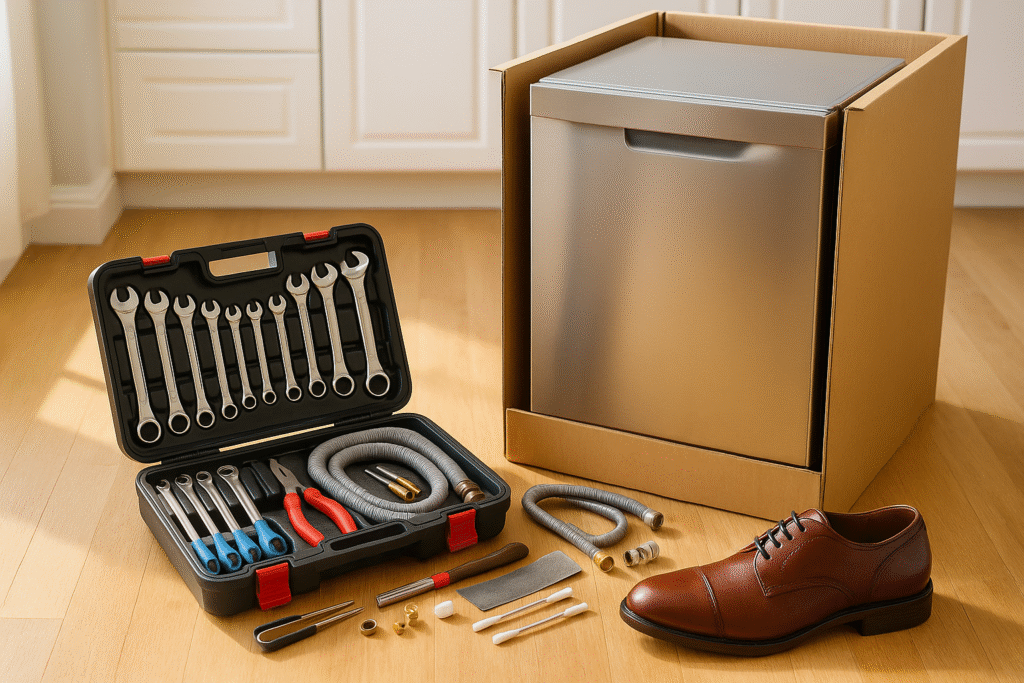
Step 1: Remove the Old Dishwasher Safely
The first stage in managing your dishwasher replacement cost is removing the old appliance properly. Even if you hire a professional, knowing this process helps you understand the labor portion of the bill and why installation costs vary. If you’re attempting a DIY swap, removing the old dishwasher safely sets the foundation for a smooth replacement and avoids damage to plumbing or cabinetry that could add unnecessary expenses.
Start by shutting off the power at the circuit breaker. Most dishwashers are either hardwired into your electrical system or plugged into an outlet under the sink. Confirm there’s no electricity flowing by testing the controls. Next, turn off the water supply connected to the dishwasher. This is usually located under the sink where the inlet hose meets the shutoff valve. Place a towel or bucket nearby to catch any water that may drain out once you disconnect the hose.
Carefully remove the lower kick plate panel at the bottom of the dishwasher. This will expose the wiring and water connections. Disconnect the electrical wires if hardwired, or unplug the unit if it uses a standard outlet. Then, detach the water supply line with an adjustable wrench, and finally, disconnect the drain hose that runs to the garbage disposal or sink drain. Take your time during this step—damaging pipes or electrical lines can increase your overall dishwasher replacement cost significantly.
Once everything is disconnected, unscrew the mounting brackets that secure the dishwasher to the countertop. Slowly slide the unit out of its space, being careful not to scratch the floor. Having a helper is useful since dishwashers can be bulky and heavy. Place the old unit aside for disposal. Many installers charge extra fees for haul-away, so if you plan to remove it yourself, you may save between $50 and $100. Properly removing the old dishwasher without causing damage ensures you’re on track for a cost-effective installation.

Step 2: Prepare the Space and Connections
After removing the old appliance, the next step in managing your dishwasher replacement cost is preparing the installation space. Many homeowners underestimate this stage, but proper preparation prevents leaks, electrical issues, and unnecessary delays that could increase labor charges. Even if you’re hiring a professional installer, being aware of what’s involved ensures you can anticipate the work being done and the costs associated with it.
Begin by cleaning the area where the old dishwasher sat. Wipe away any dirt, dust, or water stains, and inspect the flooring and cabinetry for damage. Uneven floors may require adjustment with shims to ensure the new dishwasher sits level. Next, check that the water supply valve and electrical wiring are in good condition. If the valve is corroded, stiff, or leaking, replacing it now will prevent future issues. Similarly, inspect the outlet or wiring box for wear or damage that could impact safe operation.
Measure the opening dimensions to confirm that your new unit will fit properly. Most dishwashers are standardized at about 24 inches wide, but variations exist, especially in older kitchens. If cabinetry adjustments are needed, factor that into your dishwasher replacement cost. Small modifications may only require labor, but major alterations can add significantly to your budget. Ensuring the space is ready before the new unit arrives avoids last-minute surprises.
At this stage, it’s also smart to lay out the installation kit, including the inlet hose, drain hose, and clamps. Pre-taping water connections with Teflon tape will save time during installation and reduce the risk of leaks. If you’re reusing existing hoses, check for wear or cracks, as replacements typically cost $20–$50 but can prevent costly water damage. Proper preparation of the space and connections helps control the overall dishwasher replacement cost while ensuring a secure and lasting installation.
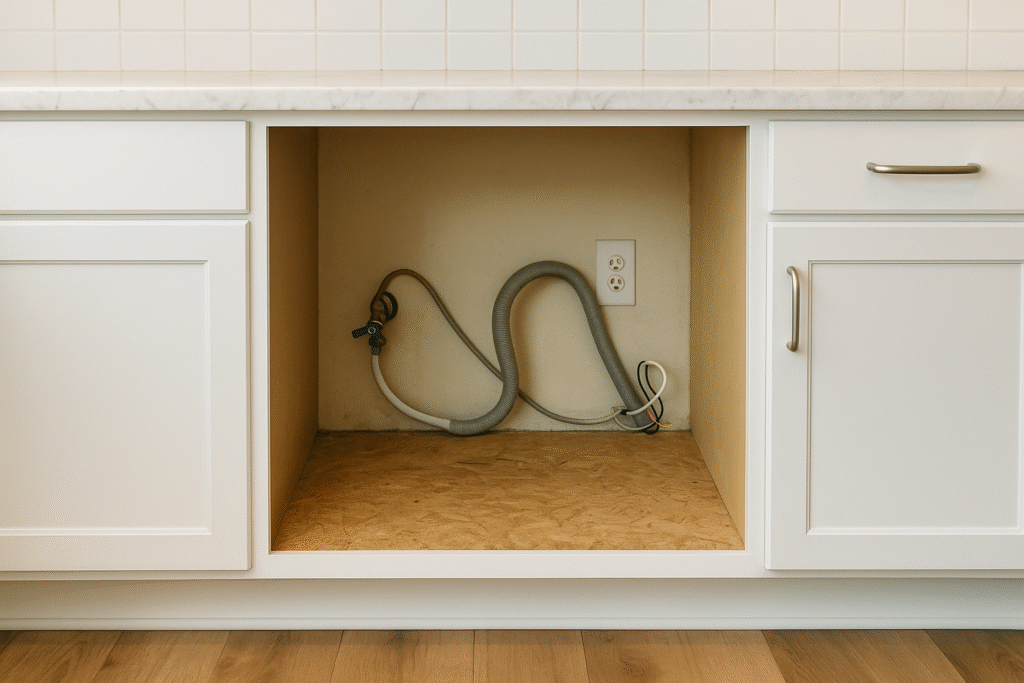
Step 3: Install the New Dishwasher and Test
With the space prepared, the final step in managing your dishwasher replacement cost is installing the new unit correctly. This stage determines whether the appliance functions efficiently and avoids issues like leaks, electrical faults, or uneven alignment. A precise installation not only protects your investment but also ensures you don’t incur extra expenses from future repairs caused by improper setup.
Begin by carefully sliding the new dishwasher into the prepared space. Thread the power cord, water inlet hose, and drain hose through the designated openings as you position the unit. Be sure not to pinch or kink the hoses, as this could restrict water flow or drainage. Align the dishwasher so that it sits evenly with your countertop and cabinetry, then use a level to make final adjustments. Secure the unit with the mounting brackets provided in the installation kit to prevent shifting during use.
Next, connect the water supply line to the shutoff valve using an adjustable wrench, ensuring that Teflon tape is applied to prevent leaks. Attach the drain hose to your sink drain or garbage disposal, securing it with a clamp. Finally, connect the electrical wiring: plug the unit into a nearby outlet or hardwire it, depending on your setup. If hardwiring, ensure the power is still off at the breaker and use wire connectors to secure the connections safely.
Once all connections are complete, turn on the water supply and restore power at the breaker. Run a test cycle to check for leaks, unusual noises, or error messages. Observe the dishwasher during its first few minutes of operation to ensure water fills correctly and drains properly. If everything functions smoothly, reinstall the lower kick plate panel and clean up the work area. Completing this step effectively ensures that your dishwasher replacement cost results in a reliable, long-lasting installation.

Common Mistakes to Avoid When You Replace a Dishwasher
Many homeowners underestimate the complexity of replacing a dishwasher, and small oversights can quickly increase the overall dishwasher replacement cost. Being aware of common mistakes helps you avoid unnecessary repairs, water damage, or safety hazards, ensuring your investment lasts as long as possible. Whether you’re hiring a professional or doing it yourself, steering clear of these pitfalls is crucial for a smooth installation.
One of the most frequent errors is failing to shut off the water and power before removing the old dishwasher. Forgetting this step risks electrical shocks, leaks, or short circuits, all of which can add costly repairs to your budget. Another common mistake is reusing worn-out hoses or connectors. While it may seem like a way to save money, old parts are more prone to leaks, which can cause significant damage to flooring or cabinets—far exceeding the small savings. Always inspect and replace worn components to control your dishwasher replacement cost.
Incorrect leveling is another mistake often overlooked. A dishwasher that isn’t level can cause poor drainage, leaks, or even damage to the internal pump. Using a level during installation ensures the machine operates correctly and quietly. Similarly, improper drain hose installation is a widespread issue. Without a proper high loop or air gap, dirty water can backflow into the dishwasher, leading to unsanitary conditions and expensive repairs.
Lastly, skipping the test cycle before finalizing the installation is a big error. Running a test allows you to spot leaks, electrical issues, or misalignments before sealing everything in place. Failing to test could mean reopening the unit later, which adds time, effort, and potentially extra service costs. By avoiding these mistakes, you can keep your dishwasher replacement cost under control and ensure a safe, efficient setup.
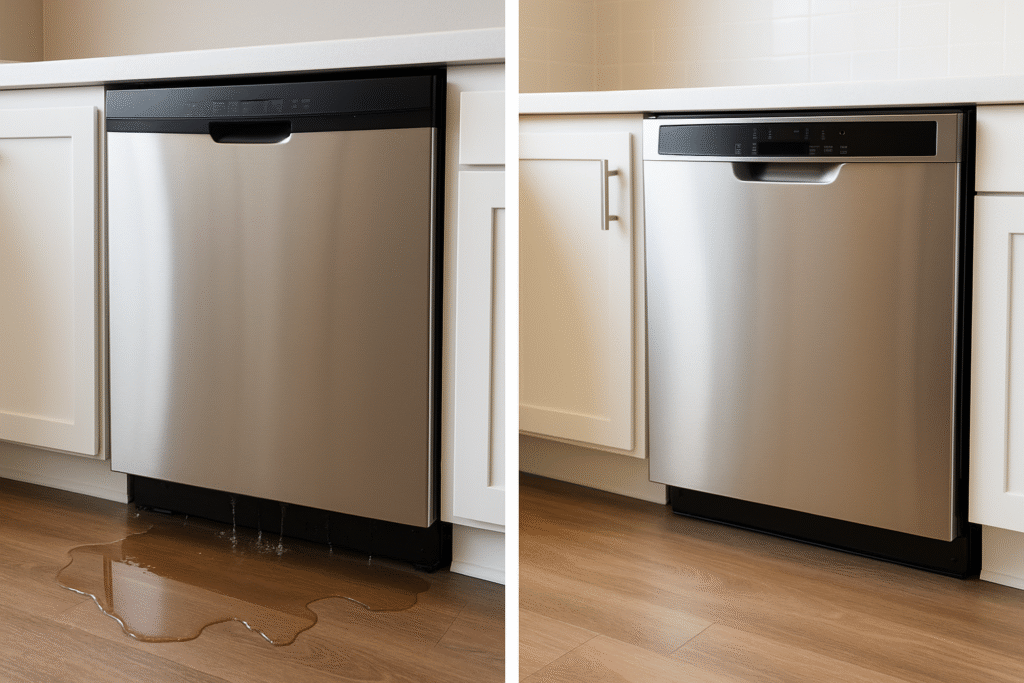
Alternative Methods for Managing Dishwasher Replacement Cost
While a full replacement is often necessary, there are alternative strategies that can help reduce your overall dishwasher replacement cost. Depending on the condition of your current unit and your budget, these options might buy you extra time, provide short-term savings, or even eliminate the need for replacement altogether. Exploring alternatives is especially useful if your dishwasher fails unexpectedly and you’re not ready for a major expense.
One approach is repairing instead of replacing. Many common issues—such as drainage problems, faulty door latches, or clogged spray arms—can be fixed for $100 to $300, far less than the cost of a new unit. Replacing a heating element or pump motor may be more expensive, but if the rest of the dishwasher is in good condition, repairs could extend its life by several years. Always compare the repair estimate to the age of the appliance; if your dishwasher is under ten years old, repair is often the smarter choice.
Another method is considering refurbished or open-box models. Appliance stores often sell these units at discounts of 20–40% compared to brand-new models. While they may have minor cosmetic flaws, they usually come with a warranty, making them a cost-effective option. This can significantly lower your dishwasher replacement cost while still providing a reliable appliance.
For those looking to save on installation, DIY replacement is another possibility. While it requires some skill and confidence with plumbing and electrical connections, handling the installation yourself can save $150–$350 in labor fees. However, this option is only recommended if you’re comfortable with tools and safety protocols, as mistakes can lead to water damage or electrical hazards.
Lastly, consider upgrading to an energy-efficient model. Although the upfront price may be higher, the long-term savings on water and electricity bills help offset the initial dishwasher replacement cost. Many energy-efficient appliances also qualify for rebates or incentives, further reducing the expense. By exploring these alternatives, you can balance cost, functionality, and convenience in a way that works best for your household.
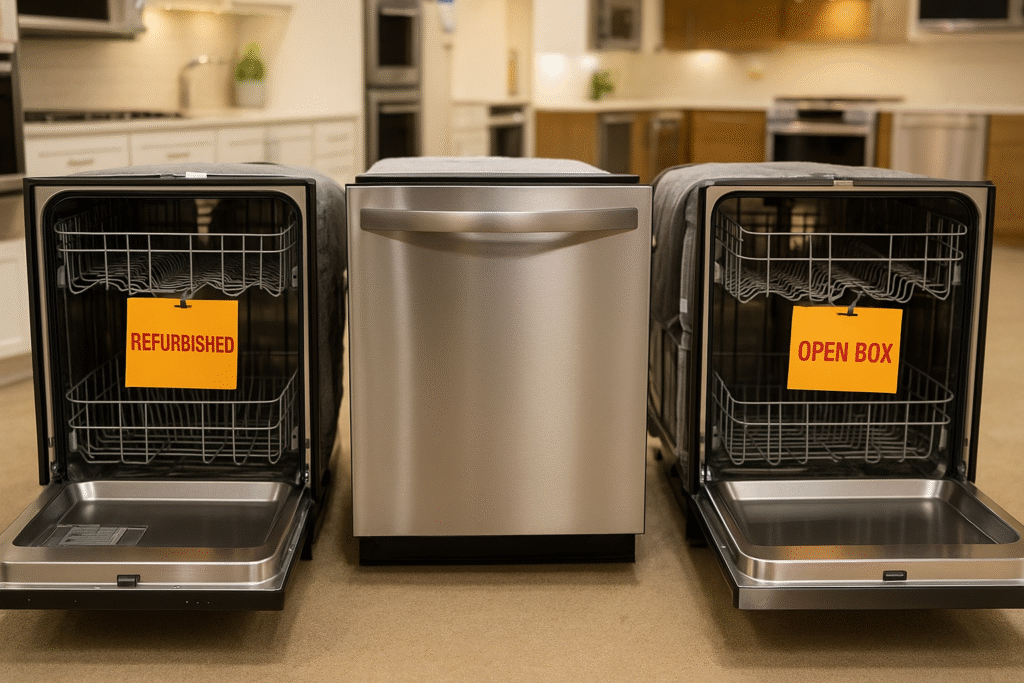
Expert Tips and Best Practices
Managing your dishwasher replacement cost isn’t just about finding the cheapest option—it’s about making smart choices that ensure value, durability, and efficiency over the long term. Experts recommend considering both the upfront cost and the lifetime savings that come with a reliable, energy-efficient appliance. Choosing wisely at this stage can prevent costly repairs and replacements down the road.
One of the best practices is to invest in energy-efficient models certified by ENERGY STAR. While these units may have a slightly higher purchase price, they use less water and electricity, saving you money on utility bills every month. Over the lifespan of the dishwasher, those savings often outweigh the initial cost difference. Additionally, some regions offer rebates or incentives for energy-efficient appliances, further lowering your dishwasher replacement cost.
Experts also suggest shopping during seasonal sales, such as Black Friday or end-of-year clearances. Many retailers offer steep discounts during these times, especially on large appliances. Another tip is to negotiate installation and haul-away fees—some companies bundle these services for free if you ask, which can save up to $100. Reading customer reviews and consulting trusted resources like the Consumer Reports dishwasher buying guide can help you choose models that are proven to perform well and last longer.
When budgeting, don’t forget about long-term care. Regularly cleaning filters, checking hoses, and running maintenance cycles keeps your dishwasher in peak condition, reducing the risk of early replacement. Spending a small amount of time and money on maintenance can stretch your investment significantly. By combining smart purchasing decisions with consistent care, you’ll keep your dishwasher replacement cost manageable and enjoy reliable performance for years to come.
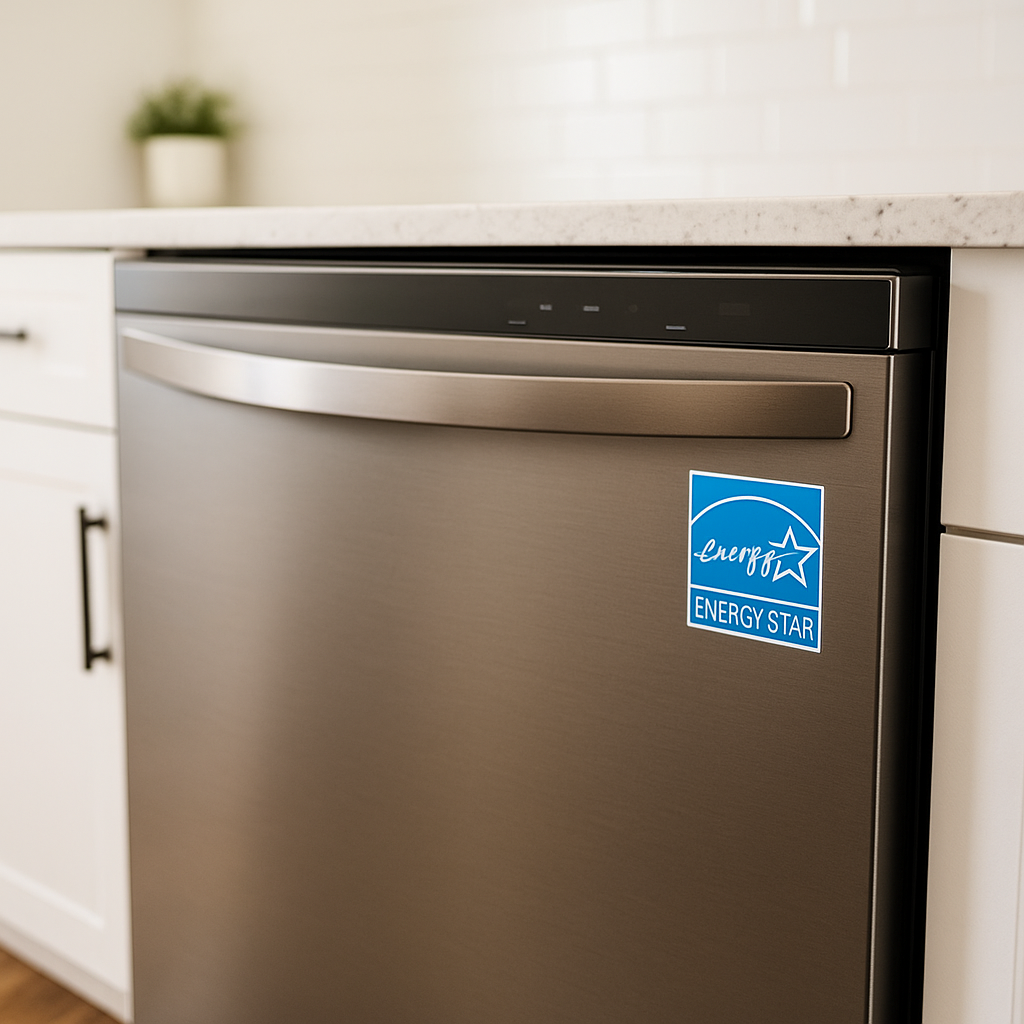
Frequently Asked Questions About Dishwasher Replacement Cost
When planning for a new appliance, homeowners often have similar concerns about the total dishwasher replacement cost. These FAQs cover the most common questions and provide clear answers to help you budget effectively and avoid hidden surprises.
How much does it usually cost to replace a dishwasher?
On average, the cost to replace a dishwasher ranges from $600 to $1,700, including the unit and professional installation. Basic models can start as low as $300, while premium options with advanced features may exceed $1,500.
Is it cheaper to repair or replace my dishwasher?
Repairs typically cost between $100 and $400, depending on the issue. If your unit is relatively new and the repair is minor, fixing it may be more cost-effective. However, if the appliance is over 10 years old or requires major parts, replacement is usually the smarter investment in terms of long-term dishwasher replacement cost.
What additional costs should I expect?
Beyond the appliance and installation, you may encounter fees for delivery, removal of the old unit, disposal, or cabinetry adjustments. These extras can add $50 to $300 to the total. Always confirm with your installer or retailer to avoid unexpected charges.
Can I install a dishwasher myself to save money?
Yes, DIY installation can save $150–$350 in labor costs. However, it requires confidence in handling plumbing and electrical work. Mistakes may lead to leaks, electrical hazards, or warranty issues. For detailed comparisons, refer to Family Handyman’s DIY dishwasher installation guide.
Do energy-efficient dishwashers really save money?
Yes, ENERGY STAR-certified dishwashers use less water and electricity, which lowers utility bills over time. While they may cost more upfront, the long-term savings can reduce your overall dishwasher replacement cost.
By understanding these common concerns, you can budget more accurately and make confident decisions when replacing your dishwasher.

📌 Read Similar Topics
- 10 Powerful Ways to Clean Range Hood Fan Motor Effectively
- How to Change a Car Air Filter: 7 Easy Steps
- 10 Proven Tips to Adjust Cupboard Doors for Perfect Alignment
- 10 Genius Ways to Shorten a Bracelet Effortlessly
- Fix a Hole from Curtain Rod: 7 Expert Ways
Conclusion: Putting It All Together
Understanding the full scope of dishwasher replacement cost empowers you to make informed decisions that balance affordability, efficiency, and long-term value. From selecting the right model to budgeting for installation and potential extra fees, every step contributes to the final price. Knowing what tools you need, how to prepare your space, and the common mistakes to avoid ensures that your investment results in a smooth, worry-free installation.
One of the key takeaways is that replacement costs are more than just the sticker price of the appliance. Labor, haul-away fees, plumbing or electrical adjustments, and optional upgrades can all influence the total expense. By accounting for these factors ahead of time, you’ll prevent surprises and keep your budget on track. Equally important is considering the long-term savings of energy-efficient models, which reduce utility bills and may even qualify for rebates.
Whether you opt for professional installation or a DIY approach, patience and preparation are critical. A carefully installed dishwasher will not only operate efficiently but also extend the lifespan of your appliance, ensuring you get the most out of your investment. When compared to repeated repairs or water damage caused by improper setup, taking the time to do it right pays off significantly in terms of overall dishwasher replacement cost.
By following this guide, you now have a clear understanding of what goes into replacing a dishwasher, how to avoid unnecessary expenses, and how to maximize your value. With the right planning, your new dishwasher will serve you reliably for years to come, making the cost well worth it.

Share this:
- Click to share on Facebook (Opens in new window) Facebook
- Click to share on X (Opens in new window) X
- Click to share on LinkedIn (Opens in new window) LinkedIn
- Click to share on Reddit (Opens in new window) Reddit
- Click to share on X (Opens in new window) X
- Click to share on Threads (Opens in new window) Threads
- Click to share on WhatsApp (Opens in new window) WhatsApp

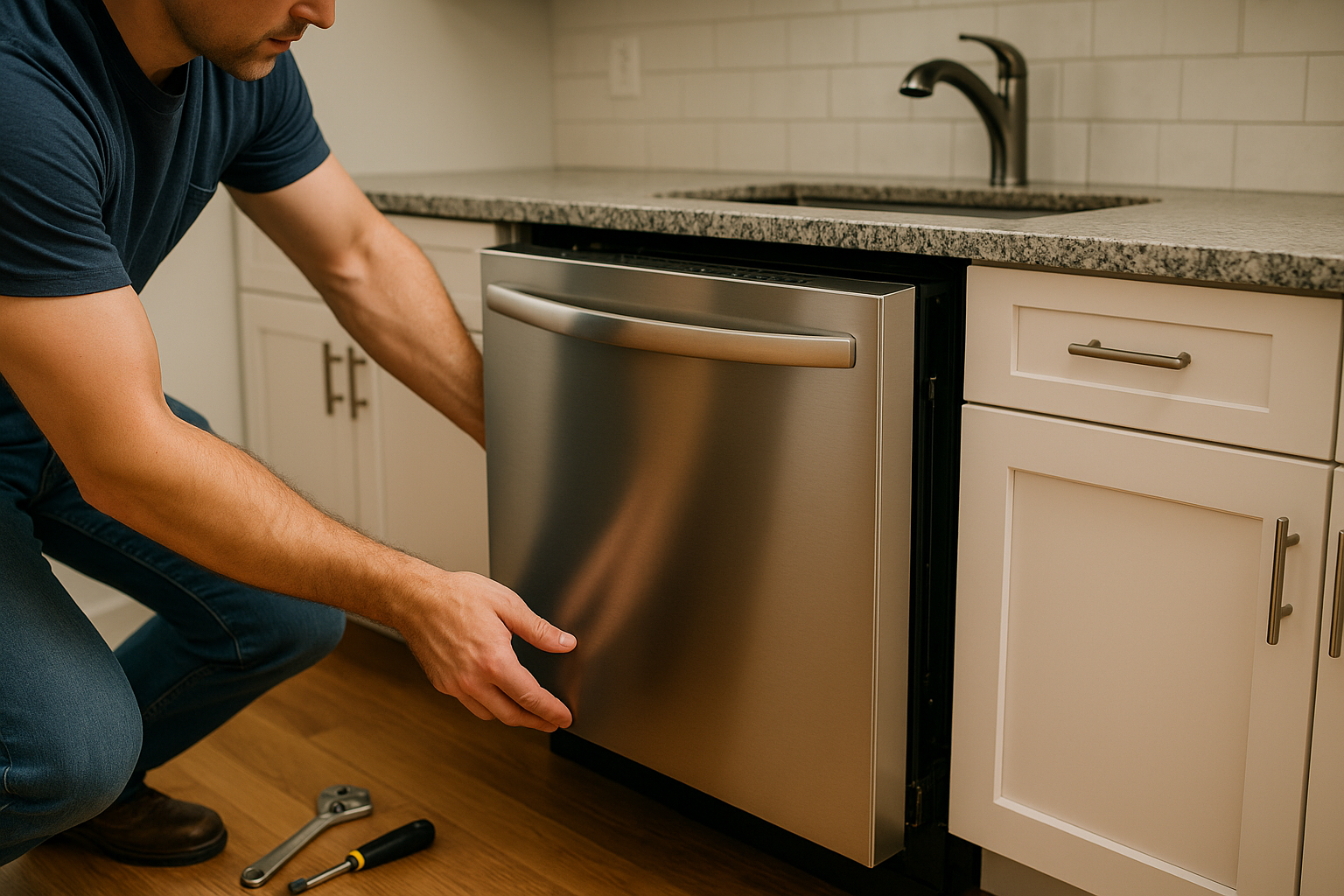



Pingback: Bathtub Baking Soda Hacks For Amazing Easy Cleaning
Pingback: How To Check Oil Levels Easily: Essential Guide For Beginners
Pingback: How To Check Brake Pads Safely: Expert Tips That Work
Pingback: How To Cook A Lobster: Easy, Delicious & Foolproof Guide